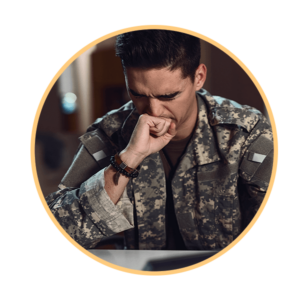Airway Clearance Therapy for NTM Patients
Read More
Since 2001, more than 3 million United States military men and women have deployed overseas. In recent years, indications have emerged that U.S. military personnel that have deployed may be at a greater risk for developing lung disease symptoms and, in some cases, disabling chronic lung diseases including asthma, chronic obstructive pulmonary disease (COPD), bronchiectasis and constrictive bronchiolitis.1
Soldiers who have been deployed in the past have a higher chance of developing respiratory diseases due to desert dust, chemicals from paint fumes, diesel exhaust, and other airborne exposures that can contribute to lung problems. Deployed soldiers are frequently exposed to harmful air pollution and smoke from open-air burn pits that are used to destroy chemicals, metals, and combustion products. Prolonged exposure to these conditions can lead to airway irritation, lung damage and respiratory tract infections.2
Among VA patients who served in Iraq and Afghanistan, the prevalence of asthma nearly tripled between 2003 and 2011, from 1.1 percent to 3.1 percent and the rate of COPD also increased from 0.31 percent to 0.55 percent. Approximately 34,000 out of a total study population of more than 760,000 Veterans, around 4.5 percent, had chronic lung diseases.3

There is so much more to learn about the reasons why veterans are at a higher risk for respiratory diseases such as COPD and Bronchiectasis so that medical and military personnel can identify policies and practices that will improve prevention, diagnosis, treatment and the support that is provided to active duty military members, veterans and their families. The US Army Medical Department, Veterans Administration (VA), and other research agencies within the Department of Defense (DoD) are actively pursuing numerous scientific investigations into deployment lung disease to better define the severity and prevalence of acute and chronic respiratory disease.4 In 2018, the COPD Foundation advocated for Congress to include COPD in the Department of Defense’s (DOD) Congressional Directed Medical Research Program. While COPD was not added as a separate topic, it was listed as one priority area under respiratory health, in hopes that the research community takes advantage of this opportunity to submit more grants.2
Prompted by the concerns raised in the press and case report data about the pulmonary health of returning military personnel, a group convened in February 2010 at National Jewish Health in Denver. The National Jewish Health Deployment-Related Lung Disease Program in Denver, Colorado, is focused on the diagnosis and treatment of active military, veterans and contactors with lung conditions related to their mission. Some general recommendations included conducting standardized pre- and post-deployment medical surveillance; establishing criteria for medical referral and diagnosis; and developing case definitions for key deployment-related lung diseases.5
For veterans, getting a proper diagnosis is the first step. Diagnosing a lung disease in the early stage of the disease is extremely important for the adaptation of appropriate treatment and management options of symptoms. Medical professionals can be proactive in recognizing post deployment respiratory symptoms and possible lung disease.
Anyone who has been deployed and has complained of respiratory symptoms such as chronic coughing, shortness of breath and repeated respiratory infections should receive an evaluation, to include chest imaging and pulmonary function testing, as early as possible. This will help ensure appropriate treatment and boost the odds of good outcomes.6
When post deployment patients are referred to a pulmonologist for evaluation of respiratory symptoms, the approach should include thorough occupational, environmental, and medical histories along with complete PFTs and chest HRCT scan. Other tests that should be considered in the diagnostic approach to patients with post deployment lung disease symptoms.5

Depending on the diagnosis, treatment options may include antibiotics that reduce inflammation and kill the bacteria infecting the bronchi, manual chest physical therapy and airway clearance devices that loosen and expel any excess mucus from the lungs, or expectorants and prescription drugs that help thin mucus so that it is easier to cough up. Depending on the patient’s condition, a doctor may recommend a bronchodilator, inhaled corticosteroids, airway clearance therapy, or surgery to remove part of the infected airway.
When choosing an airway clearance therapy, it is important to take into consideration both the patient’s and the physician’s suggestions and preferences. An airway clearance regimen should be effective, efficient, easy to use, able to be undertaken independently or with minimal assistance, and should improve lung function. It should also be flexible, comfortable and adaptable to meet the changing needs of the individual patient.
AffloVest offers a great alternative to manual chest physiotherapy (CPT).
Advantages:
AffloVest is the first battery-operated High Frequency Chest Wall Oscillation therapy that allows veterans with respiratory diseases such as bronchiectasis and COPD, receive state-of-the-art airway clearance therapy on the go.
References
1. Weese, C., Abraham, J. (2009) “Potential health implications associated with particulate matter exposure in deployed settings in southwest Asia.” Inhal Toxicol 21: 291–29
2. Silpa D. Krefft, MD et al, “Deployment-Related Lung Disorders” Fed Pract. 2015 Jun; 32(6): 32–38.
3. Pugh MJ,et al “Increasing Prevalence of Chronic Lung Disease in Veterans of the Wars in Iraq and Afghanistan.” Mil Med.2016 May;181(5):476-81. doi: 10.7205/MILMED-D-15-00035.
4. Morris MJ1, et al “Diagnosis and management of chronic lung disease in deployed military personnel.” Ther Adv Respir Dis.2013 Aug;7(4):235-45. doi: 10.1177/1753465813481022. Epub 2013 Mar 7.
5. Rose, C., Abraham, J., Harkins, D., Miller, M., Morris, M., Zacher, L.. (2012) Overview and recommendations for medical screening and diagnostic evaluation for post-deployment lung disease in returning US warfighters. J Occup Environ Med 54: 746–751.
6. Szema AM, Salihi W, Savary K, Chen JJ. Respiratory symptoms necessitating spirometry among soldiers with Iraq/Afghanistan war lung injury. J Occup Environ Med. 2011;5:961-5.
Call us at 1.800.575.1900